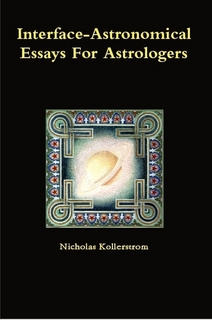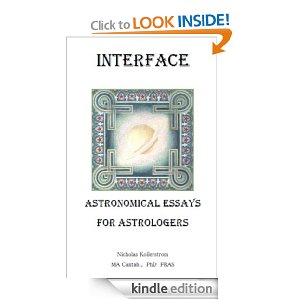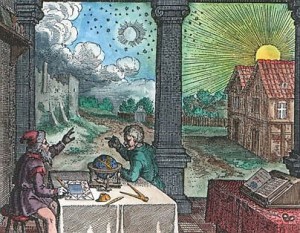Interface, Astronomical Essays for Astronomers
0May 20, 2012 by NewAlchemyPress
This is a book about reconciliation and coming-together, about a synthesis between astronomy and astrology that could change our world. We are the heirs to a tragic and schizoid breach between these two: for three centuries a male, left-brain, rational materialistic science battled against an intuitive, spiritual, feminine art. This strife needs to heal up in this new millenium.
The most creative cultures in the past experienced a unity between astrology / astronomy, as Professor Richard Tarnas has observed: “…our greatest progress in planetary astronomy came precisely during the periods when astrology was most part of the cultural zietgeist – the Hellenistic era, the high Middle Ages, and the Renaissance.”
“Once there were creatures of light leaping across the firmament, and the pattern of their movement filled the heavens. But the creatures soon fled and in their place appeared great spheres of crystal which turned within each other, their song vibrating through all the strings of the world. These harmonies were too lovely to last. A clock was ticking in the pale hands of God, and already it was too late. Yes. The wheels of the mechanism began to turn.” – Peter Ackroyd First Light, 1989, p.3.
Contents Foreword by Melanie Reinhart * Prologue: A Time for Synthesis * Imagination and Reality * Space Probes and Planetary Images * Venus, the Rose and the Heart * Galileo, Astrologer * Johannes Kepler’s Chart * Ophiucus, the 13th Sign? * Galactic Alignment, AD 1998 * Our Mathematical Moon * The Star-Zodiac of Antiquity * Synchrony of Neptune’s Discovery * Pluto Demoted * The Bok Dialogues
The ‘Galactic Alignment’ has has received a lot of attention online, what does this mean to us and how doed such an alignment actually happen? Is it astronomy or astrology? The galactic alignment helps to show us our place in the Milky Way and was only discovered in the 20th century.
These essays also look at ancient astronomy, how are zodiac signs fixed in the heavens, and why do they keep drifting ever further apart from the constellations from which they originated?
Ancient astronomy and astrology both have relevant messages for our times if studied together as in these essays. Johannes Kepler made a plea for not losing the inherent connection between astronomy and astrology. He figured out some new astrological aspects as well as his laws of planetary motion. We here examines his chart showing how the new astrological aspects he discovered feature in it. We look at his astrology and compare it with that of Galileo.
Our mysterious moon does not quite fit with astronomers’ theories, there is nothing else like it in the universe. It is a riddle surrounded by enigmas – Earth’s neighbour and yet so different. Can it maybe it gives us a clue as to how life evolved here? Planetary images from space probes have been confirming ancient astrological beliefs. For example, Galileo viewed the sun as the fiery heart-center of our solar system, and was he somehow right?
Melanie Reinhart, the well-known British astrologer, has written a Forward to this volume.
NK has co-edited two volumes with Dr Nick Campion as ‘Culture and Cosmos’ special issues: Galileo’s Astrology 2003 176pp, and Kepler’s Astrology 2010 (published 2012), 328 pp. Both are definitive works on their subject.
* Interview in The Mountain Astrologer, Dec 1995, p.25.
The book is in black and white, so you might find that the color-images I’ve done here of the planets, get you in the mood.
Book Review of Interface (1st Edition), by Dennis Elwell, Astrology Quarterly, Summer 1998.
‘Reading these thoughtful essays, I realised afresh what a loss it is that astrologers have yet to reach a consensus on what sort of universe they are living in. Nor have they developed their special view of reality in a coherent and comprehensive way. In blinding contrast, astronomers have no doubt at al about the nature of their universe, but the author’s audacious thesis is that astrology has yet much to teach them. He deplores the schism between astronomy and astrology that has lasted for three and a half centuries, and suggests that with the millennium upon us it might be possible to work towards a reconciliation.
‘If only! The big question is whether astrology, as it stands at present, possesses the vitality to struggle meaningfully with mechanistic science. Dr Kollerstrom is fascinated by the parallels to be drawn beten the physical characteristics of the planets and their astrological significance, and offers some eye-opening facts. Thus he describes how the Voyager space probe arrived at Uranus, to discover that it and its moon Miranda had all the bizarre eccentricities that astrologers might have suspected. He goes on: ‘After managing so well their precision hardware for the Voyager mission, the astrophysicists ought now to turn to the astrologer, who could hep them appreciate what it al means. Otherwise they will merely be left with a lot of gee-whiz data that cannot be pieced together.’
‘Apart from pointing out that the latest observations of the solar system tend to confirm astrological expectations, it must be doubted whether current astrological knowledge is so well organised that it could even begin to piece them together to demonstrate ‘what it all means.’ Astronomers would be more convinced if astrologers had told them, in advance of the mission, what Voyager would find. So we are back with the familiar problem, of how astrology can offer a more robust challenge to conventional explanations, or at least to augment them. Some of the ten essays in this volume expose the inadequacies of those explanations, as one draws away from the ‘third rock from the Sun’ to observe the Moon and planets. Needless to say, while astrophysicists admit to gaps in their understanding, they insist that given time the laws of physical science will prove adequate – and without any assistance from astrologers, thank you!
NK believes that astronomy and astrology are two sides of the same coin. Obviously both study the heavens. But surely they can only belong to the same coin to the extent that astrology is prepared to embrace the causal mechanisms of physical science, otherwise they must remain poles apart, approaching phenomena like eclipses from utterly different standpoints? Part of the reason that astrology does not present a united front is that whereas some researchers are not prepared to look beyond physical explanations for observed astrological effects, for others the value of astrology is that it points to causes which are supraphysical. Until astrologers reach agreement among themselves they perhaps do not deserve to be heard.
‘The picture might have been different if giants like Kepler and Galileo, with a foot in both camps, had effectively reconciled the differences in their own minds. Two of Kollerstrom’s illuminating essays, and two appendices, are devoted to Kepler and Galileo, and make it plain that the latter’s astrological interests have been suppressed by a hard-nosed science anxious to claim it for their own.
‘NK is himself admirably positioned to present an astrology in which direct physical effects on the one hand, and synchronistic phenomena on the other, can co-exist. His previous publications have included lunar planting and the planetary metals, both subjects on which he might find some measure of official scientific interest, if not approval. Yet he is not afraid to step outside the strict parameters of physical science, as here, with an essay about the baffling media attack on astrology over its alleged omission of the ‘13th sign’ of the zodiac, Ophiuchus.
‘He present a chart for sunrise on the day the story broke, and finds planetary links with another attack by 18 Nobel laureates and other leading scientists some 20 years earlier. I must say I pondered for a long time over the Ophiuchus chart, as he calls it, because it is important to ask what any chart is really saying. If we claim it represents reality, then what reality, whose reality? For astrologers this chart marked a spontaneous media campaign in which their most publicised tenet – a 12-sign zodiac- was held up to ridicule, without them being able to mount an effective defence. Yet from the rationalist viewpoint it represented a major triumph over superstition, a breath of fresh air, and there must have been much smugness among the ‘I told you so’ brigade to find themselves thus vindicated. Or is a chart like this neutral, giving comfort to neither side? Does it represent a non-partisan comment on earthly events from some higher level of description?
‘Maybe astrology itself is all about a higher level or organisation, and should not strain its unique insights too far for the sake of reaching an accommodation with the discoveries of physical science. Those discoveries are usually provisional, and on their way to becoming something else, which – at a rendezvous in the far future –may be more easily reconciled with the astrologer’s vision. Meantime, in the bridge-building necessary for an eventual understanding, astrologers like NK offer a safe pair of hands.’Diana Rosenberg, in The Mountain Astrologer, Jan 1998:
‘NK, an astrologer with a Ph.D in the History of Science, has set himself an ambitious goal: he will be satisfied with nothing less than restoring the glorious structure of the real sky to astrologers, and its anthropocentric meaning, mystery, and wonder to astronomers. To this end he has written Interface, Astronomical Essays for Astrologers, a collection displaying his wide range of erudition and study.
‘Each essay elucidates an area he has studied in depth: the exquisite patterns woven by the planets in their long-term cycles; the senselessly rigid scientific training that teaches astronomers that they absolutely may not use their imagination to understand the significance of their discoveries; the images beamed from space probes that affirm the ancient ‘signatures’ of the planets; the mysterious resonance tying the Earth to the length of Venus’s day; details (and proofs) concerning the activities of Galileo and Kepler as astrologers, with new information about Galileo’s horoscope; the recent flap over Ophiuchus being “the 13th sign”; the 1975 CSICOP attack by 186 scientists; the emergence and development of our zodiac of signs and its source constellations; the Galactic Alignment of 1999 (when the Galactic Equator reaches an exact intersection with the ecliptic), which can only happen once every 13,000 years!
‘As Melanie Reinhart’s excellent foreword points out, “Nick’s work opens the door on the world of symbols and correspondences elucidated through connections old and new.” In each essay he highlights the extraordinary “coincidences” that form the structure of our celestial habitat: for instance, the fact that the Moon can exactly eclipse the sun because the Sun is 400 times larger than the Moon in diameter, and 400 times farther away; the amazing synchrony of the Saros cycle: for synodic cycle months it comes to 18 years, 11 1/3 days, equal to those of the Node-cycle months of 18 years, 11 1/3 days, equal to Apogee-Perigee months of 18 years, 11 ½ days. And then there’s the Metonic cycle, wherein 235 Synodic periods of the Moon equals 19 cycles of the Earth around the Sun, to within two hours!
‘I found synastry conections between the charts of famous astronomer/astrologers fascinating. I noticed, for instance, that Galileo’s Neptune is the same degree as Kepler’s Mars, and Galileo’s North Node is the same degree as Kepler’s Mercury! The difficult attempt at collaboration between Kepler and Tycho Brahe was certainly not helped by the fact that Brahe’s Pluto was on Kepler’s MC, and Nick points out that while Tycho’s chart had a predominance of septiles, Kepler’s, in contrast, was chock full of quintiles, demonstrating their essentially incompatible temperaments. Another “coincidence” that Nick discusses is the virtually exact opposition of the Royal Stars Aldebaran (the Bulls Eye) and Antares (the Scorpion’s Heart). These two doozies turn up on virtually every turning point, including national, racial, religious and nuclear issues! And there’s more …’
See my new article Power of the Sun, about what makes the Sun shine.
Spaceprobes see the planets Pluto Demoted The Planets, and Solary System Geometry The Naming of Neptune Mystery of the Moon Speedy Mercury Galactic Evolution The Galactic Alignment
Category alchemy, ancient astronomy, ancient astronomy and galactic alignment, astrology, astronomy, galactic alignment, Galileo, history of science, Johannes Kepler, science | Tags: astrology, astronomy, Galactic Alignment, Galileo, Kepler, planets







Leave a Reply